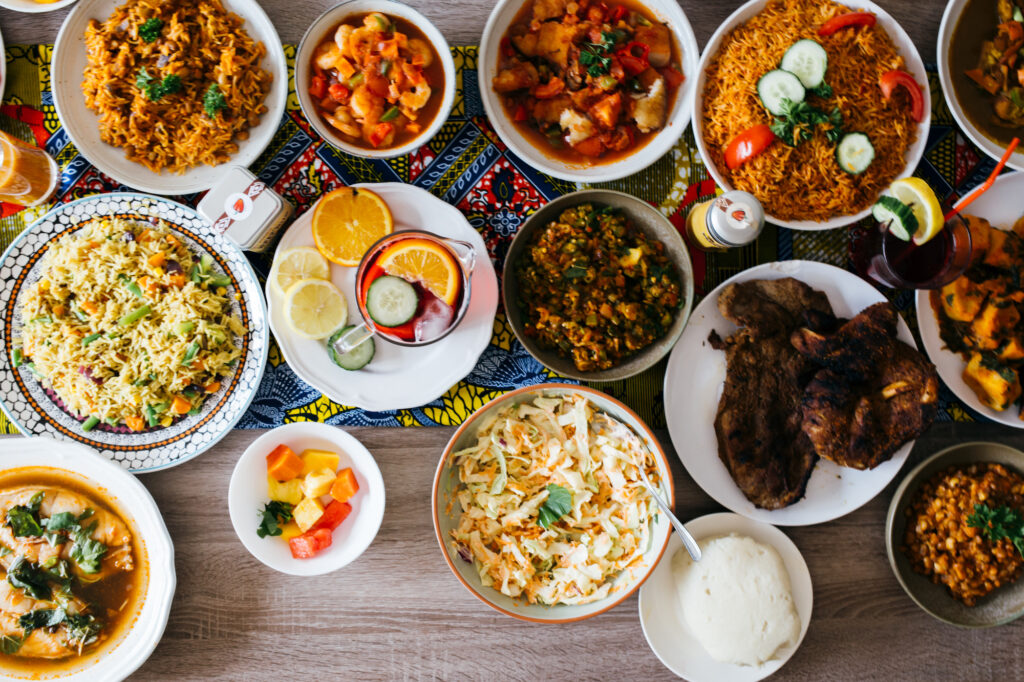— Learn all the key regional dishes across Africa with Africa on a Plate, weekdays at 2pm on SBS Food or stream it on SBS On Demand. —
Who would be better than homegrown chefs to take people on a culinary journey across Africa? That was the rhetorical question that inspired Lentswe Bhengu to make the TV series Africa on a Plate.
“We’re unapologetically focused on black businesses,” the producer and co-host tells SBS Food. “The reason I started Africa on a Plate is because I wanted African chefs talking about African cuisine in Africa. There wasn’t content like that anywhere back then. We were listening to Jamie Oliver and Gordon Ramsay and all these guys coming here and talking about our food.”
The series starts in Bhengu’s home country, South Africa, then moves through Tanzania, Nigeria, Morocco, before it returns south to Lesotho. Here are a few things you should know before getting stuck in.
1. There isn’t one single African cuisine
Bhengu with fellow chef and co-host Zama Memela showcase the many faces of African cuisine. Being the second-largest continent by geographical area and population after Asia, Africa encompasses many cuisines.
In North Africa, you can find tagine, couscous, pastilla, ful medames and koshari. West Africa is home to jollof rice, moimoi, waakye and superkanja.
You can find tagine in North Africa.
Central Africa is where you can eat groundnut stew, makayabu, and many cassava and plantain-based dishes.
In East Africa, you’ll find various wat served on injera flatbread, ugali, grilled seafood, sambusa and mashed matoke, while in South Africa, you can eat bunny chow, biltong and barbecued meat at a shisa nyama or braai.
3. It’s all about what’s grown locally
Bhengu says, “The different African cuisines are directly related to the produce grown specifically in those regions. If you go to Central, East and West Africa, they use lots of cassava, they have certain types of ingredients that only grow in that area.
“All the way towards the north, in Morocco, you have sweeter fruits, it’s more Mediterranean-like.”
The bases of many dishes often comprise of rice and other grains like millet and sorghum, bread, legumes or starchy vegetables and fruit like cassava, yam and plantain.
Millet forms the base of many dishes in Africa.
2. You’ll also find foreign influences
African countries are influenced by each other and places further abroad. The Egyptian koshari and South African bunny chow have Indian origins. On the Swahili Coast, ingredients like pomegranate juice remind us of Middle Eastern flavours. Central Africa’s makayabu is a local version of Portugal’s bacalhau.
“I wanted African chefs talking about African cuisine in Africa.”
South Africa’s cuisine is especially diverse and is often referred to as “rainbow cuisine”. “We have so many other nationalities calling South Africa home; Dutch, Indian, English, French and other African countries. We’re a big melting pot of other communities within one,” says Bhengu.
In the South African episodes of Africa on a Plate, Bhengu visits the country’s first black-owned winery, researches how to make the perfect curry, prepares his version of a traditional Zulu tripe dish and explores many other facets of his country’s cuisine.
This tasty rice and lentil dish is Egypt’s national comfort food. Flavoured with tomato, garlic and chilli, it’s hearty, flavoursome and inexpensive to prepare. Koshari is a specialty of street vendors who dish it out from huge metal cauldrons. It’s also a staple in Egyptian homes, commonly eaten during meat- and dairy-free fasts during Lent and Christmas.
4. Spices and condiments are a must
Because loads of spices grow in Africa, they are the cornerstone of many dishes.
Cinnamon, ginger and cumin are especially popular throughout the continent, as are spice blends like berbere, ras el hanout, dukkah and tsire. Spice-filled hot or sour condiments such as harissa, piment écrasé and chermoula also give some punch.
Benghu travelled to Zanzibar to find out more about the spices there. “The spice trade is huge there, it’s the spice mecca of Africa so I had to visit a couple of spice farms,” he says.
Spice, herb and nut blend dukkah is the perfect accompaniment to many dishes like these lamb cutlets.
5. African cuisine deserves its place in the sun
Many Australians consider themselves worldly eaters, but African cuisine hasn’t entered the mainstream here in the same way that Asian and European cuisines have.
Chef Duncan Welgemoed of Adelaide restaurant Africola told SBS Food in November, “I don’t like talking ’bout trends because they generally fizzle out. But I do think the potential for more households to draw the influences of African food into their own repertoire is immense. More people will start eating African food, because it’s vegetable and grain-heavy and packed with flavour.”
“More people will start eating African food, because it’s vegetable and grain-heavy and packed with flavour.”
If you need a point to start your African home cooking adventures, tune it to Africa on a Plate, where Bhengu and Memela will take you from street stalls to high-end restaurants across the continent.
“I wanted to unearth those stories and put them on this big platform. African cuisine is not given a platform like Asia and Western continents,” Bhengu says.
Source: https://www.sbs.com.au/food/article/2020/12/15/five-things-you-need-know-about-african-cuisine
